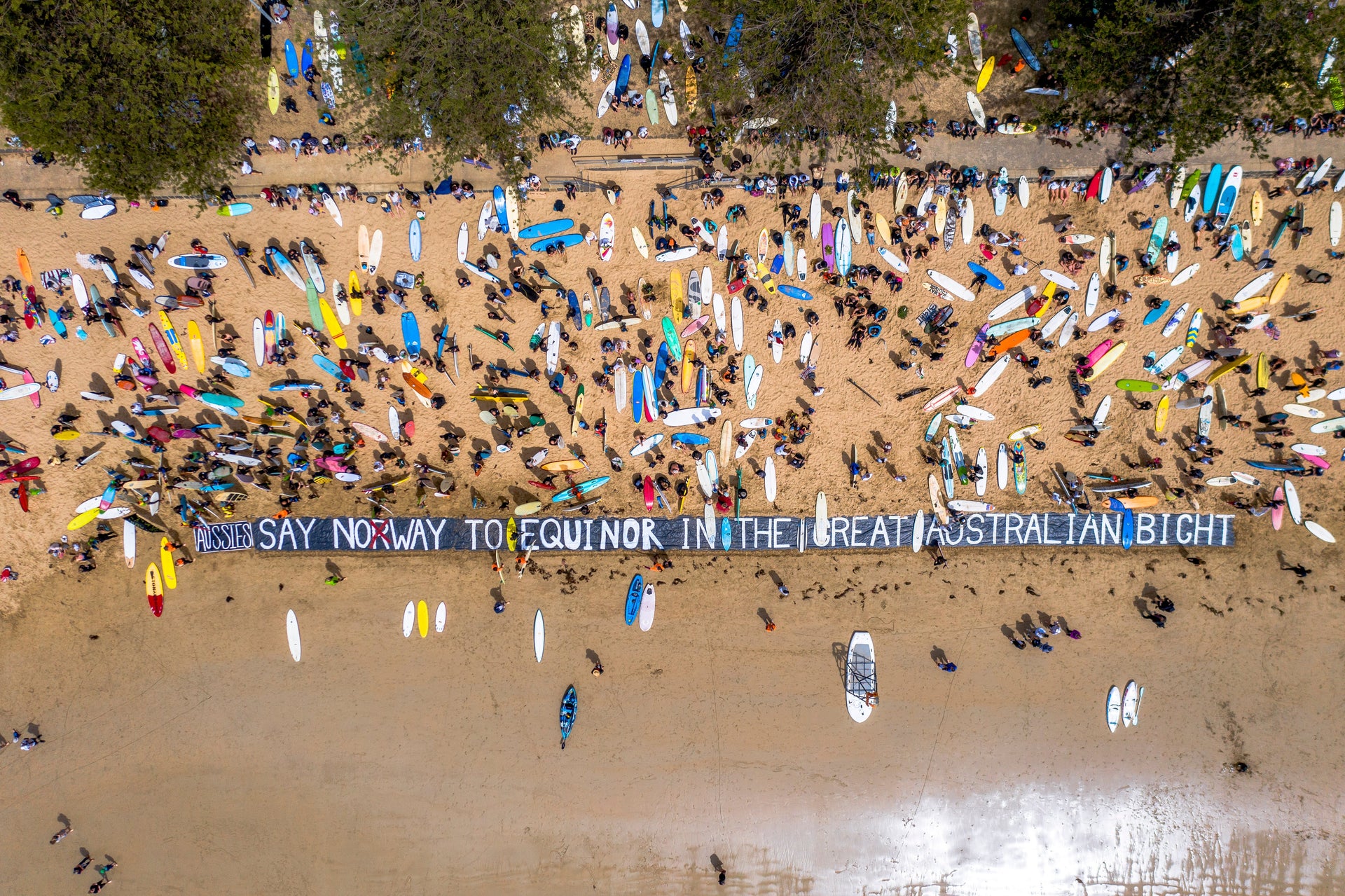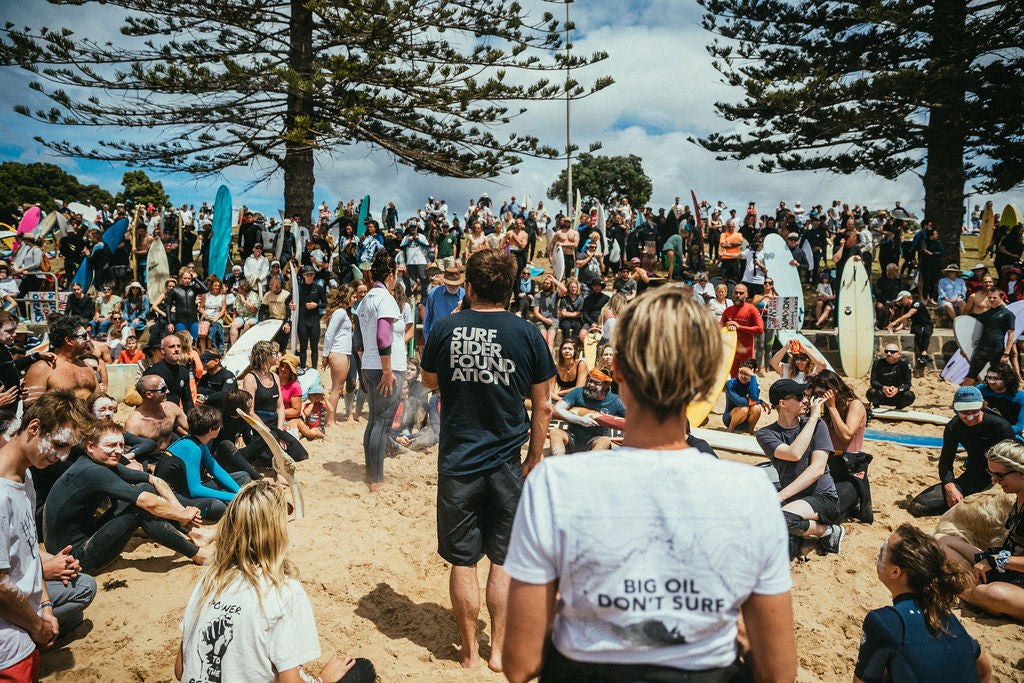The Byron crew were just starting to prepare for their paddle-out later that morning; one of 60 planned that day right around Australia protesting against a plan to turn the Great Australian Bight into a deep water oil field. Ben Miller, the head of the local Surfrider chapter, was scratching his head wondering where to set up. “How many people do you reckon will show up?” I suggested they set up in the park next to the Byron Surf Club. This was Byron after all, the activism and protest capital of the country, but beyond that, the Bight issue has gained huge traction with surf communities right around Australia. “Could be pretty big,” I offered. As I said that Ozzie Wright pulled up and pulled a 12-foot high, three-headed bat creature out of his van, the wings emblazoned with “Fight for the Bight”. The paddle-outs were part of a national statement but were all taking on a very local feel. This one was very Byron.

November 23, paddle out in Byron Bay, NSW. Photo: Matty Hannon.
The National Day of Action to save the Great Australian Bight was designed to really get Equinor’s attention. The Norwegian fossil fuel company lodged their plan to drill for oil in the Great Australian Bight earlier this year, and have been locked in a battle with surfers around the country ever since. Surfers collectively haven’t had much to protest in recent decades. For a surfer, this is the land of milk and honey, and the last time surfers took to the beaches en masse in protest was back in the ‘90s when they were still pumping raw sewerage onto the beaches at Manly and Bondi, and the French were detonating nuclear bombs in the South Pacific.
Not a lot of surfers head down to the Bight. It’s remote, raw, and regulated by heavy locals both in the car park and swimming around in the lineup. The plan to frontier drill for oil has the potential for a spill to end up on beaches across two-thirds of Australia’s surfable coastline. But beyond that, the issue has become emblematic of the threat to coastlines right around the country, particularly from offshore oil and gas development. The Bight has been a trigger for surfers to mobilise and draw a line in the sand.
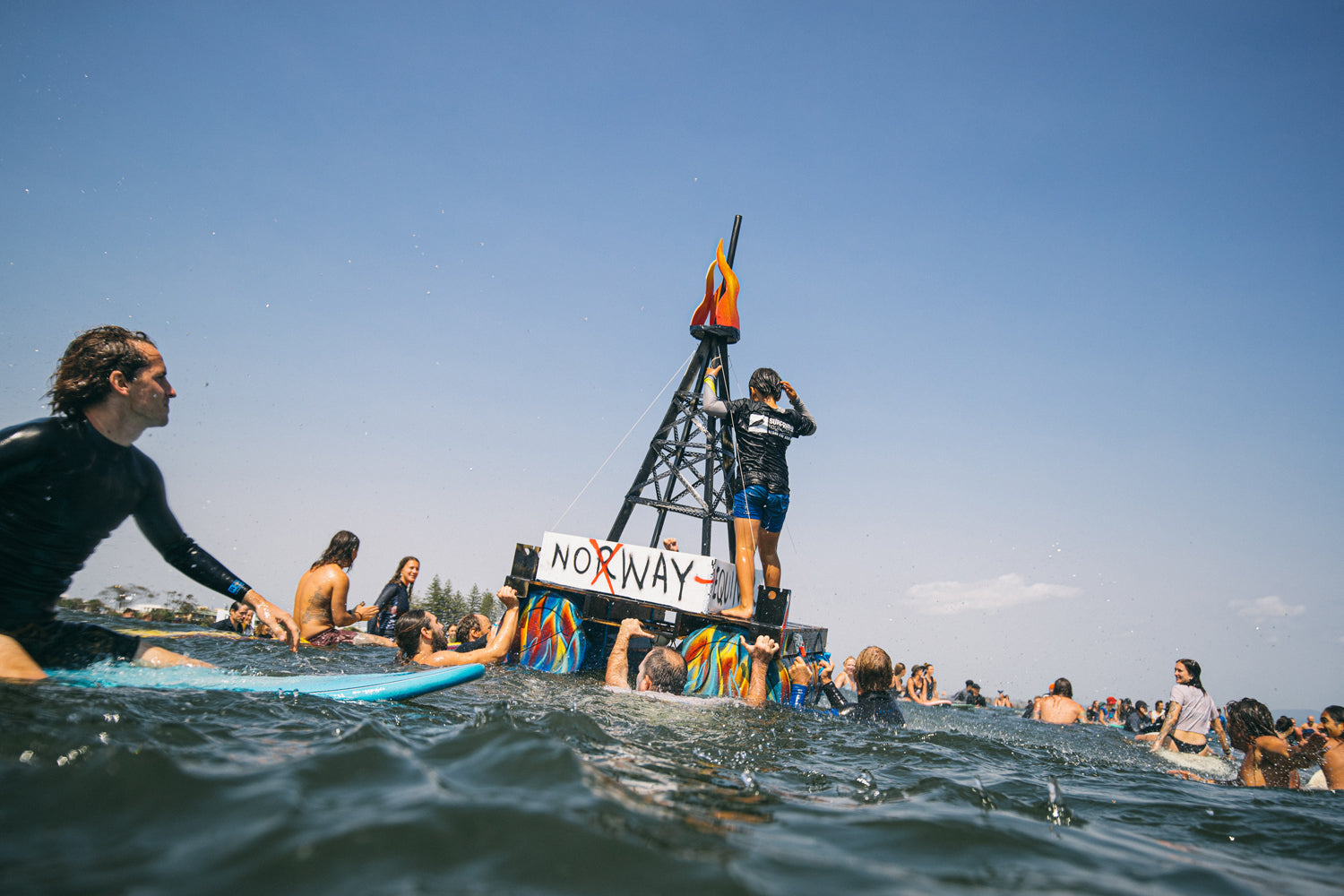
Byron Bay surfers rally around a replica oil rig. Photo: Nathan Oldfield.
The Byron show was already humming when I left for the Gold Coast paddle-out. Arriving at Currumbin Alley it was already clear there’d be a crowd. I had to park four blocks away and walk 10 minutes in. Joel Parkinson was double parked. Mick Fanning didn’t bother trying to park and instead chose to paddle his board up the coast from his place down at Kirra. There were people everywhere. The Gold Coast runs by the adage of "the family that surfs together stays together", and the crowd were just that – mostly families. There were three generations of the Brooks family there – Rod, Troy, and groms Jahli and Bodhi. Former ironman competitor Wes Berg was there with his daughters. The turnout was great, the only problem was that the outgoing tide and northeast wind had turned Currumbin Alley into a mess, leaving the open front beach the only option for the paddle-out. It was only two-to-three feet, but the shorebreak was slamming and would claim a few victims by the end of the day.
Earlier this year when the first paddle outs went down, the Gold Coast event at Burleigh had seen 3,000 people turn up. It was significant. At that point, the issue had just broken, largely due to Equinor’s own spill modelling being released showing the potential for oil between Albany and Port Macquarie – across 5,000km of coast… 6,000km if you include Tasmania. The significance of the Burleigh paddle out in March was that Burleigh was nowhere near any potential oil spill. Port Macquarie was 500km to the south. That meant the crew at Burleigh hadn’t paddled out to save their coast, they’d paddled out to save someone else’s coast over 3,000km away.

In the water at Currumbin, QLD, on November 23. Photo: Trent Mitchell.
The primary issue had been oil drilling in the Bight but it has become much more than that. The eastern states of Australia have been in the grip of one of the worst droughts on record. All year we’ve seen images of dying inland rivers and a seemingly endless run of unseasonal record temperatures across the country. Over the past month though the problem has moved closer to home. The north coast of NSW and parts of southern Queensland have been on fire for weeks, unprecedented bushfires are still burning. But as the fires raged, governments both federal and state flatly refused to discuss why. Whenever the effect climate change might be having on the intensity of the fires was mentioned the topic was immediately deflected. “Not today” became the stock response from politicians as they posed for press ops in fire-effected areas. The denialism, if it wasn’t so serious, would have been comical.
"It’s Stone Age thinking at a time we should be making big decisions about the future."
Australia’s Federal government is stacked with climate deniers and has its head so far up the ass of the fossil fuel industry it’s impossible to tell where one stops and the other starts. Australia has become a First World quarry as fossil fuel companies embark on a wholesale expansion right across the country – including the Bight. Australia has become the biggest exporter of coal and gas in the world at a time when the effects of climate change are landing on our doorstep with a sense of reckoning. It’s Stone Age thinking at a time we should be making big decisions about the future. It’s made blood boil. People are pissed. The weekend was significant. If you’ve got surfers interrupting their Saturday surf to protest in huge numbers, then you’ve really got a problem.
Damien Cole and Belinda Baggs address the cowd in Torquay, VIC. Photo: Jarrah Lynch.
Cheyne Horan’s been thinking about it a lot. Speaking to Cheyne before the Currumbin event, he was telling me of a dream he’d recently had. Cheyne’s dreams are famously vivid and, as surfing’s resident futurist for many years, always possess a clairvoyant quality. Lately, he’s been dreaming about a future on fire. Cheyne addresses the crowd, which included probably a thousand kids. “This fight is for all you grommets. We’re here today for you and your grandchildren.” This was about the future, but also echoed the past. There was a strong indigenous presence on Saturday, not only at Currumbin but right around the nation at all the paddle-outs. Most of the events began with a Welcome to Country by local traditional owners and the Aboriginal flag was flown proudly. For 60,000 years the traditional owners had handed down country to the next generation as they’d found it. They took just enough from it and no more. They understood its rhythms and how they belonged in the landscape. That worked for 60,000 years but in the space of two generations that basic idea of handing down a better world has been broken… and here we are.
Australia has taken to the streets to protest rampant fossil fuel expansion – first the kids, and then the activists. The Australian Prime Minister just the week before, addressing a meeting of the coal industry, promised to draft new laws to arrest anyone specifically protesting against fossil fuel companies. He’d labelled them “radical activists” and promised to throw the book at them. Looking around at Currumbin I didn’t see anyone who could be labelled a radical activist. This wasn’t Extinction Rebellion. These were coastal communities. Most of them had never protested anything before and that’s why these gatherings were so important. There was nothing “fringe” about this crew. They weren’t easily dismissed. They also tapped into possibly the most Australian thing you can do – going to the beach and throwing yourself into a three-foot shorey. I publicly offered myself for arrest but there were no police anywhere at any of the paddle-outs. Scott Morrison would need to come down and arrest us himself.
"The Bight has been a trigger for surfers to mobilise and draw a line in the sand."
The real power of the paddle-outs though was their geographic breadth. They were spread all around the Australian coastline, far beyond the reach of any potential oil spill. At the same time, right around the country, people took to the water in Agnes Water, Albany, Avalon, Bicheno, Bombo, Bondi, Boomerang, Bundaberg, Byron Bay, Cactus, Capricorn Coast, Clifton Beach, Coffs Harbour, Culburra, Currumbin, Denmark, Devonport, Elliston, Esperance, Forster, Hobart, Kalbarri, Kangaroo Island, Kianga, Lennox Head, Mallacoota, Mandurah, Manly, Margaret River, Merimbula, Middleton, Mollymook, Mornington Peninsula, Newcastle, Norman Bay, Nubeena, Park Beach, Perth, Phillip Island, Port Fairy, Port Lincoln, Port Macquarie, Port Noarlunga, Port Wilunga, Portland, Sandy Point, Scamander, Streaky Bay, Sunshine Coast, Torquay, Townsville, Victor Harbour and Yallingup. On the day paddle-outs spot-fired. One maddog paddled out alone into croc-infested waters in Darwin carrying a Fight For The Bight sign. Many of them were modest affairs organised by boardriding clubs, maybe 50 surfers tops. Some of them like Torquay, Byron, Bondi, Manly and Currumbin were huge, with between a thousand and 3,000 people.
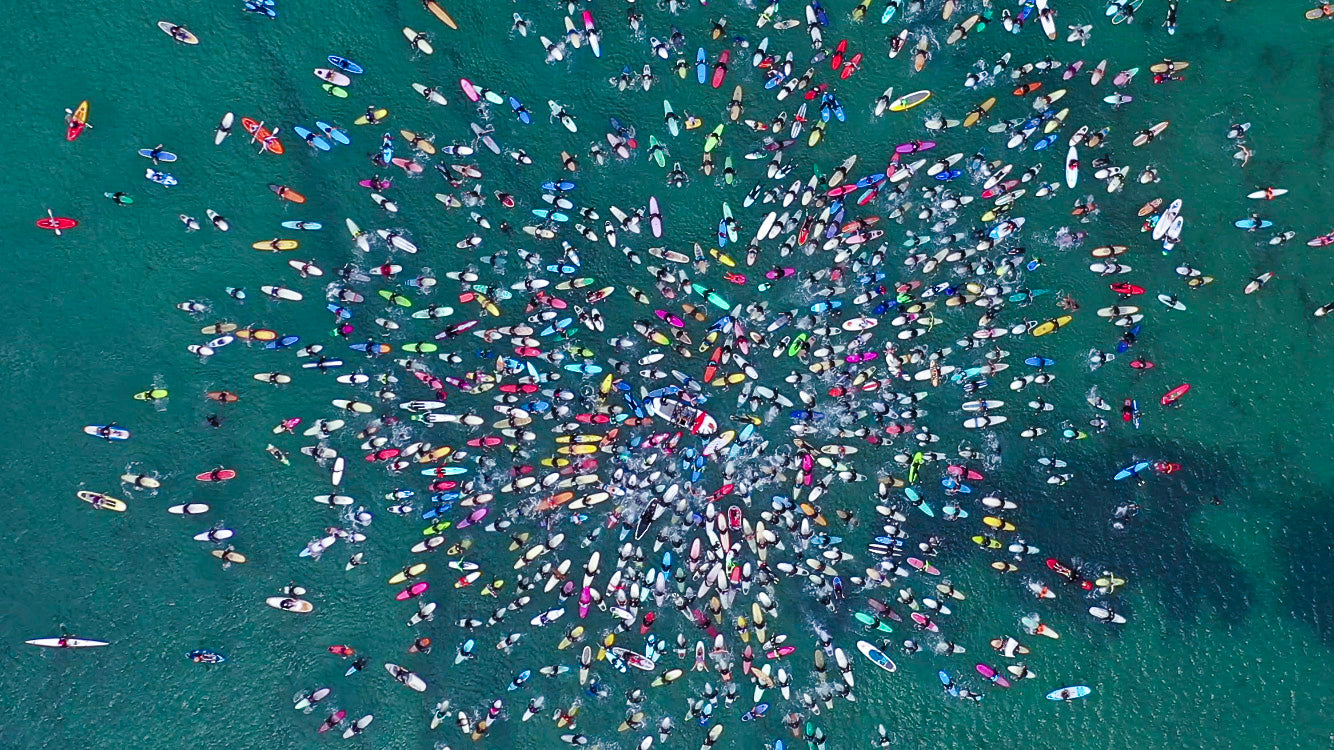
The Torquay community were out in solidarity. Photo: Guillermo Sundheim.
But maybe the most important paddle-out was held a few hours later, half a world away in Lofoten, up in the north of Norway. During the whole Bight campaign, some of the strongest support has come from the small Norwegian surf community. There’s not a lot of them, but the Norwegian surfers have been crucial. Equinor is two-thirds owned by the Norwegian people and has made Norway one of the richest countries on earth. But Equinor also markets themselves at home as a progressive, clean energy company. Their Instagram account (which the Fight For The Bight forced them to shut down for six months) is full of European windfarms. The reality is that Equinor spends only two per cent of its development budget on renewables and the rest of it is dirty drilling half a world away. The surfers in Norway have been one of the few groups to stand up to them and convey the reality.
At a time when great parts of the world are being divided for political gain and profit, of all people surfers have actually found a way to come together and take a lead.
Strange days indeed.
Take action now to
keep the Bight wild and free.
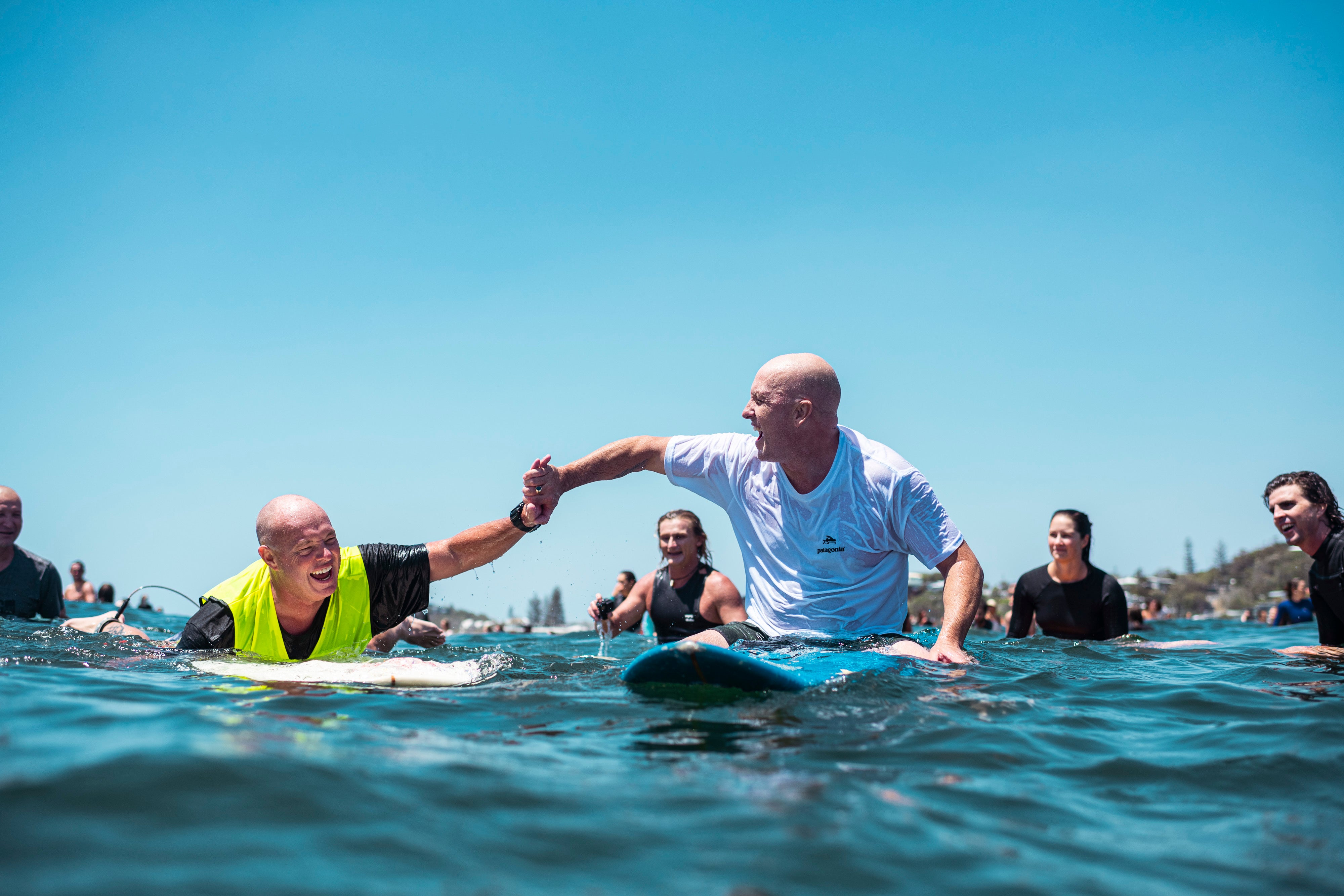
Sean Doherty at the Currumbin paddle out. Photo: Trent Mitchell.
Author Profile - Sean Doherty is a surf journalist, Surfrider Foundation Australia board member and the Brand Manager (Surf) at Patagonia Australia/New Zealand.


